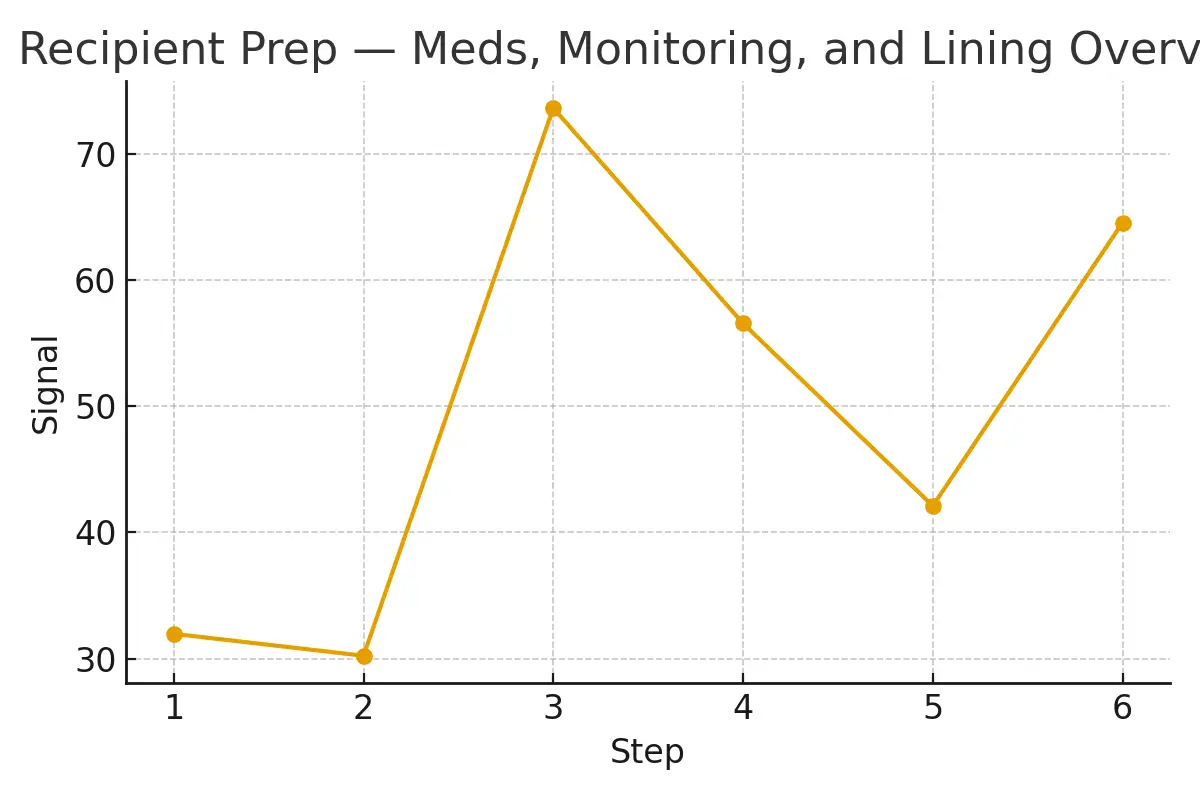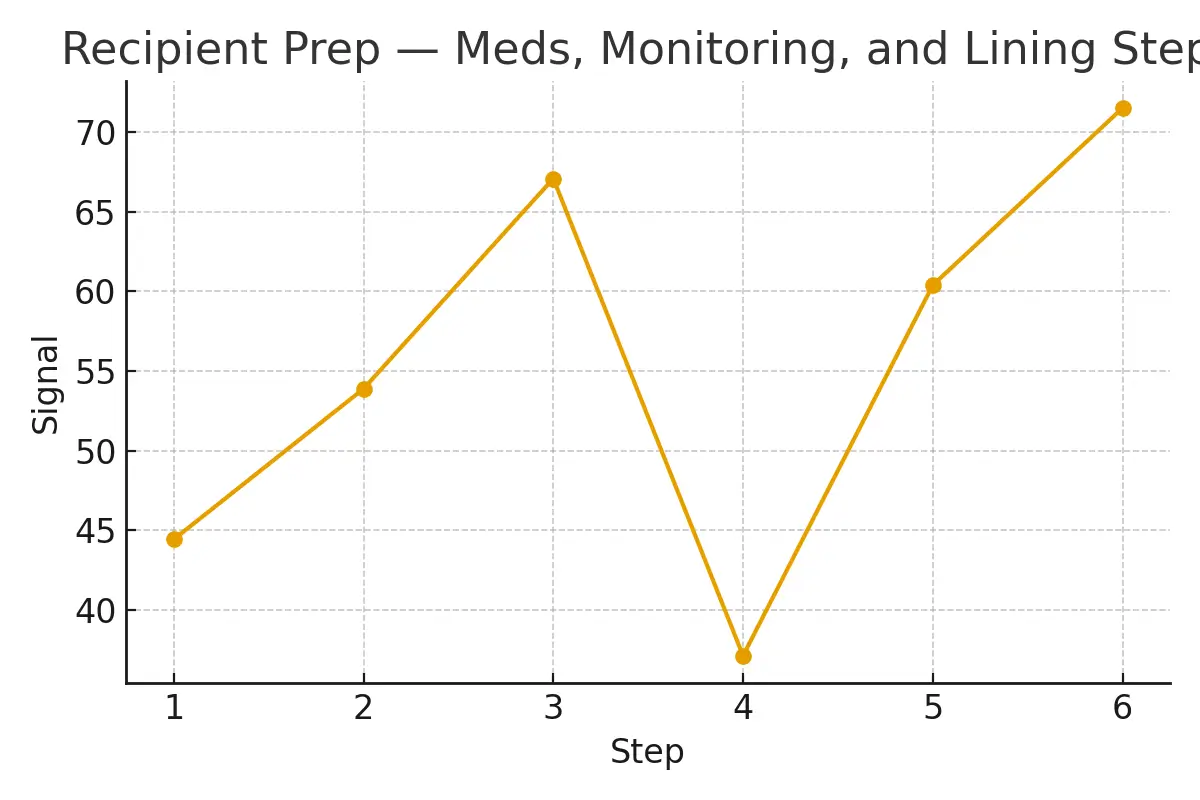
Recipient preparation is a central step within the Egg Donation 101 pathway. This stage focuses on medications, monitoring, and endometrial lining readiness. It helps intended parents understand who benefits, how timing influences outcomes, the practical costs involved, and the decision rules that keep care simple and humane.
Where Recipient Prep Fits in the Journey
Understanding Recipient Prep
Recipient prep refers to synchronizing the endometrium with the egg donor’s cycle or the embryo transfer timeline. The goal is to ensure the uterine lining is receptive, stable, and timed precisely for implantation.
Why It Matters
This step defines when transfer can occur, affects the likelihood of success, and influences the emotional and financial predictability of the process.
Eligibility Signals and When to Pause
Who Benefits
- Individuals or couples using donated eggs
- Patients with diminished ovarian reserve
- Recipients requiring strict timing control
- Families planning frozen embryo transfers
Signals to Proceed
- Stable thyroid, prolactin, and vitamin D levels
- Recent uterine cavity evaluation with normal findings
- Regular access to monitoring labs or ultrasound
- Clear the cycle calendar from the clinic
Signals to Pause
- Unresolved uterine pathology (polyps, adhesions)
- Uncontrolled hormonal conditions
- Missing lab results or incomplete records
- Medication access delays
Step-by-Step Process with Timing Checkpoints
Baseline Review
- Updated medical history
- Review of uterine imaging
- Medication planning
Cycle Calendar Setup
- Align donor and recipient timelines
- Pharmacy coordination
- Confirm medication start dates
Medication Phase
- Estrogen (oral, patch, or injection)
- Progesterone (injection or vaginal)
- Adjuncts based on clinical need
Monitoring
- Endometrial thickness
- Pattern (trilaminar vs homogeneous)
- Hormone levels if required
Transfer Window
- Timing progesterone start
- Scheduling embryo transfer
- Reviewing post-transfer care
Pros, Cons, and Practical Costs
Pros
- Predictable scheduling
- High control over timing
- Works well with donor cycles
- Clinically proven protocols
Cons
- More appointments
- Medication side effects
- Higher upfront coordination needs
- Potential for cycle cancellation
Cost Breakdown (Example Line-Items)
- Estrogen and progesterone: $600–$1,200
- Monitoring ultrasounds: $250–$600 per visit
- Bloodwork: $150–$350
- Embryo transfer fee: $1,500–$3,500
- Optional add-ons: ERA, immune tests, or supplements
Outcome Drivers: What You Control vs What You Monitor
What You Control
- Medication adherence
- Timely communication with the clinic
- Pharmacy coordination
- Follow through with monitoring appointments
What You Monitor
- Lining thickness and pattern
- Hormone levels
- Cycle timing relative to the donor or embryo
- Clinic-confirmed transfer windows
Questions to Ask Your Clinic
- How many lining checks do you typically require?
- Do you prefer oral, patch, or injectable estrogen?
- What is the minimum acceptable lining thickness for transfer?
- What circumstances lead to cycle cancellation?
- How do you handle medication delays or pharmacy shortages?
- What is included in the recipient prep cost estimate?
Expert Quote
“Protect timing and keep plans simple—quality improves when noise goes down.” — Clinical Team
Patient Case Study
A couple progressed from inconclusive tests to a structured plan after aligning cycle timing and expectations with the clinic. Simplified logistics reduced uncertainty, and clear communication improved comfort and predictability, ultimately supporting a successful rate path forward.
Testimonials
“The steps finally made sense.” — A.&J., Manhattan
“Costs were clear; no surprise bills.” — L., Hoboken
“Nurses replied fast with practical coaching.” — K.&V., Queens
Additional Insights
Male Factor Optimization
Synchronizing embryo creation and transfer windows reduces timing mismatches and improves implantation opportunities.
Ovarian Stimulation (Donor Side)
Evidence-based add-ons help balance multiple-gestation risk and maintain egg quality.
Pharmacy Logistics
Reliable medication sourcing reduces variability during the most time-sensitive phase.
Cycle Cancellation Criteria
Clear rules reduce delays and help families plan more confidently.
Trigger Timing
Controls donor response and prevents overstimulation, supporting safer and more predictable cycles.
Cost and Financing Plans
Transparent, scenario-based planning allows intended parents to align expectations with outcome probabilities.
Next Steps with Surrogacy4All
If you’re ready to move forward, Surrogacy4All offers:
- Free 15-minute nurse consult (212) 661-7673
- Upload your labs for a second opinion
- Customized cost breakdown for your case
These tools simplify planning and ensure transparency every step of the way.
Frequently Asked Questions (FAQs)
Q: Is this medical advice?
Ans : No—use this information to guide clinic conversations.
Q: How many cycles should I plan?
Ans : Think in ranges. Cumulative success often matters more than any individual cycle.
Q: What drives cost most?
Ans : Medications, genetics, anesthesia, and the total number of cycles.

Dr. Kulsoom Baloch
Dr. Kulsoom Baloch is a dedicated donor coordinator at Egg Donors, leveraging her extensive background in medicine and public health. She holds an MBBS from Ziauddin University, Pakistan, and an MPH from Hofstra University, New York. With three years of clinical experience at prominent hospitals in Karachi, Pakistan, Dr. Baloch has honed her skills in patient care and medical research.





